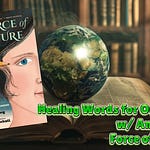Hello Everyone!
Welcome back to The Cosmic Companion.
This week, we’re talking about Jaws, Claws, Life and Death, and what they can teach us about staying alive in space! In a little bit, we’re going to be talking with Jennifer Szymanski from Nat Geo Kids about their new book, Deadliest Animals on the Planet.
But first, the boring bit of the show with me in it.
FULL EPISODE:
Both in nature as well as in space, staying warm (but not TOO warm!) is paramount to survival.
African elephants are known for their ADORABLE ears! You’re welcome!
Now Pachyderms (I LOVE that name!) chow down about 70 times as many calories each day as a typical human being. This energy is stored as heat during the day and released at night through the motion of blood vessels, acting like tiny electric blankets. Awwwww. Hi, Ellie!
Astronauts onboard the International Space Station keep things cozy by pumping ammonia through the station’s active thermal control systems (ATCS). The fluid is sent through the panels, which act like ears, shedding the heat (or not) as necessary.
Predators use their claws for hunting and survival. In space, robotic arms are used for various tasks, from repairs to capturing satellites.
Just as predators can strike an unsuspecting animal at any time in the wild, Small meteors and space debris whipping around Earth can spell doom — <<< [D-O-O-M. DOOM!] — for space travelers.
Infrared observations — looking at light which is redder than red allows mission controllers around the globe to track potentially hazardous stuff in space and get the heck out of the way.
Rattlesnakes also track infrared light using facial pits located in front of and below their eyes. Instead of searching for danger, though, these critters are in search of a snack!
Next up, we talk with Jennifer Szymanski from Nat Geo Kids about the Deadliest Animals on the Planet!
If we hope to survive as a species, we must move beyond Earth, making our home on The Moon, Mars, and beyond. Only by doing so can we develop societies beyond poverty and scarcity. Living in space is also our only assurance that our species might survive in the event of an extinction-level event on Earth.
Asteroids within our solar system can provide vast storehouses of resources which could be gathered without environmental consequences on Earth.
Next, let’s consider hibernation. Bears hibernate to save energy during winter. Similarly, astronauts could use a state of artificial hibernation, known as torpor, for long-duration space travel. Months of sleep might be possible using chemical means, or by having travelers read Return of the Native. [Hey!]
Now, let’s weave our way into the world of spiders. Spiders weave intricate webs to catch prey. Similarly, satellites weave an invisible web of connectivity around Earth, helping us communicate and navigate. It’s a cosmic web of technology!
If we’re talkin’ survival, we HAVE to talk tardigrades! This is my buddy, Terrence. Now These LUDICROUSLY adorable creatures can withstand… well, pretty much anything. Including wavelengths of radiation that can wipe out… well, pretty much anything except tardigrades. [can’t you, Terrence?] [Absolutely!]
Long-term exposure to harsh radiation in space will be one of our greatest challenges as we move into the next phase of humanity.
Tardigrades do this by protecting their DNA in a cloud of proteins called Dsup (Dee-SUPPPPP?), and by covering their skins in a pigment that turns the most-hazardous frequencies of ultraviolet radiation into harmless blue light.
There it goes now. [V>V] Thanks, Terrence. One day, space-borne habitations could protect human adventurers using similar strategies.
Communication permits space travelers to operate as a cohesive community, together with teams on the ground.
Much like a pack of wolves, space travel requires communication, as well as the ability to adapt quickly to changing conditions. Wolves teach each other skills and pass on knowledge, much like human teachers, professors, and, occasionally, hosts of comedy science shows.
Next week, we won’t have a show, as we continue work on our upcoming feature film, Gaia Rising.
Join us on 24 February, as we talk about Making Science [Even More!] Fun! Talking with Beakman himself, Paul Zaloom, from Beakman’s World!
Thanks for watching. Check out past episodes as well as our short films at TheCosmicCompanion.net, subscribe to our Substack at TheCosmicCompanion.com or follow us wherever you found this episode. I’m pretty sure we’re there. Thanks!
Clear skies!
James




















Jaws, Claws, Life, and Death w/ Jennifer Szymanski, Nat Geo Kids